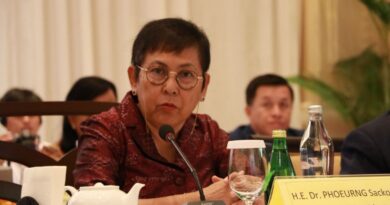ថ្មីៗនេះ មានការប្រទះឃើញដោយចៃដន្យនូវក្បាលនាគចំនួន១ធ្វើពីថ្មភក់ស្ថិតក្នុងរចនាបថបាយ័ន នៅពេលដើមស្រឡៅធំមួយដើមបានដួលរលំ បណ្តាលឱ្យបំណែកក្បាលនាគដែលកប់ក្នុងដីជាយូរឆ្នាំហើយ ត្រូវបានផុសឡើងតាមឬសឈើ នៅក្នុងបរិវេណវត្តទេពប្រណម្យ អតីតរាជធានីអង្គរធំ។
លោក ឈូក សុម៉ាឡា ប្រធានក្រុមចុះបញ្ជីវត្ថុសិល្បៈ នាយកដ្ឋានអភិរក្សប្រាសាទ និងបុរាណវិទ្យា នៃអាជ្ញាធរជាតិអប្សរាបានឱ្យដឹងថា បំណែកក្បាលនាគនេះ បានកប់ក្នុងដីជម្រៅប្រមាណកន្លះម៉ែត្រ ហើយជាក់ស្តែង ដើមស្រឡៅដែលដុះពីលើមិនមានឬសកែវធំៗ ទើបពេលភ្លៀងជោគជាំ ដីជ្រាយ ធ្វើឱ្យដួលរលំ និងផុសក្បាលនាគដែលឬសឈើដុះចាក់ស្រេះមកជាមួយតែម្តង។ លោក សុម៉ាឡា បន្តថា បំណែកក្បាលនាគនេះ មានត្រឹមតែកនាគមកក្បាលខាងលើដែលមាន បណ្តោយ១.២ម៉ែត្រ ទទឹង១ម៉ែត្រ និងកម្រាស់០.៣ម៉ែត្រ បំណែកសត្វគ្រុឌជិះលើក្បាលនាគ ស្ថានភាពមុខនាគខាងមុខមានការខូចខាតច្រើនដោយអន្លើរ ដោយបាក់បែកមុខនាគ និងជុំវិញសងខាង។ រីឯសត្វគ្រុឌវិញ ត្រូវបានបាក់ច្រមុះ និងដៃផ្នែកនៅខាងលើ រួមទាំងផ្នែកខ្លះនៃក្បាល។
លោក ឈូក សុម៉ាឡា សន្និដ្ឋានថា បំណែកក្បាលនាគនេះអាចយកចេញពីប្រាសាទបាយ័ន តែមិនដឹងថា យកមកទីតាំងនេះក្នុងគោលបំណងអ្វី និងពេលណានោះទេ។ បន្ថែមទៀតថា រូបចម្លាក់បែបនេះច្រើនឃើញនៅរចនាបថបាយ័ន ក្នុងរាជព្រះបាទជ័យវរ្ម័នទី៧ ទ្រង់បានយកនាគ និងគ្រុឌដែលជាសត្រូវនឹងគ្នាមកបញ្ចូលក្នុងសិល្បៈតែមួយ។ អាចជាព្រះអង្គចង់បង្ហាញពីទស្សនៈបង្រួបបង្រួមសាសនារវាងព្រហ្មញ្ញសាសនា និងព្រះពុទ្ធសាសនា ទើបព្រះអង្គឱ្យស្ថាបត្យករបញ្ចូលនាគ និងគ្រុឌនៅជាមួយគ្នា ហើយដាក់បង្ហាញលើសំណង់នានារបស់ទ្រង់។
ដើម្បីរក្សាសុវត្ថិភាពនូវបំណែកក្បាលនាគនេះ ទើបអាជ្ញាធរជាតិអប្សរា សហការជាមួយនគរបាលការពារបេតិកភណ្ឌ ព្រមទាំងភ្នាក់ងារទេសចរណ៍ ធ្វើកំណត់ហេតុ ប្រគល់ទទួលបំណែកចម្លាក់ខាងលើ យកទៅរក្សាទុកនៅសារមន្ទីរព្រះនរោត្តម សីហនុ-អង្គរ ដើម្បីចុះបញ្ជីទុកជាឯកសារ លាងសម្អាត រក្សាទុកទៅតាមបច្ចេកទេស និងស្វែងរកទិន្នន័យផ្សេងទៀតផងទាក់ទងនឹងបំណែកក្បាលនាគនេះ ងាយស្រួលយកទៅដាក់នៅទីតាំងដើមវិញ បើមានការជួសជុលនៅទីតាំងដែលបានបាត់បង់នោះ៕
អត្ថបទ៖ ឆាយ ផាន់នី
រូបភាព៖ លោក យី សុថា/ឈូក សុម៉ាឡា
Recently, a sandstone naga head was accidentally spotted when a large tree collapsed, causing pieces of naga head buried in the ground for many years to emerge from the tree’s roots in the area of Wat Tep Pranom, Angkor Thom.
Mr. Chhouk Somala, Head of the art registration team of the Department of Conservation of Monuments and Preventive Archaeology of the APSARA National Authority, said that the naga head sculpture was buried in the ground about half a meter deep. When the tree collapsed, the naga head sculpture was found in the tree’s roots. Mr. Somala added that the fragment of the naga head sculpture was the upper head, which was 1.2 meters long, 1 meter wide, and 0.3 meters thick.
Mr. Chhouk Somala concluded that the naga head sculpture could be removed from the Bayon temple, but did not know for what purpose and when. He added that such sculptures were often seen in the Bayon style during the reign of Jayavarman VII, who combined Naga and Garuda. Perhaps it was used to express the idea of religious unification between Brahmanism and Buddhism, so the king asked the architects to combine Naga and Garuda and display them in his temples.
To keep the pieces of the naga head sculpture safe, the APSARA National Authority cooperated with the Heritage Protection Police and the tourism agent to make a record and hand over the piece to be kept at the Preah Norodom Sihanouk-Angkor Museum for registration and cleaning as well as search for other data related to this naga head sculpture, so it is easy to put it back to its original location.
Article: Chhay Phanny
Photos: Mr. Yi Sotha / Chhouk Somala
Share:
Our Latest News

កិច្ចប្រជុំបច្ចេកទេសលើកទី៤០របស់គណៈកម្មាធិការអាយស៊ីស៊ី-អង្គរ និងសំបូរព្រៃគុក-40th Technical Session of the ICC-Angkor/Sambor Prei Kuk - 19 June 2025
កិច្ចប្រជុំបច្ចេករបស់គណៈកម្មាធិការសម្របសម្រួលអន្តរជាតិសម្រាប់កិច្ចការពារ និងអភិវឌ្ឍន៍រមណីយដ្ឋានប្រវត្តិសាស្ត្រអង្គរ និងសំបូរព្រៃគុក លើកទី៤០ ធ្វើឡើងរយៈពេល២ថ្ងៃ គឺថ្ងៃទី១៩-២០ ខែមិថុនា ឆ្នាំ២០២៥។




